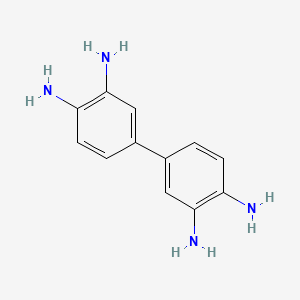D0692 | 3,3'-diaminobenzidine
| Toxicity | Dose | Time | Species | Model | Method | Action | Positive criterion | Reference |
|---|---|---|---|---|---|---|---|---|
| MEMBRANE POTENTIAL | 13.69±14.86 | human | qHTS-HepG2 | MMP assay | decrease | IC50 | 163 | |
| MEMBRANE POTENTIAL | 4.47 | human | HepG2 | MMP assay | decrease | IC50 | 163 | |
| MEMBRANE POTENTIAL | 30.66±28.30 | rat | hepatocytes | MMP assay | decrease | IC50 | 163 | |
| Pictogram | Signal | Statements | Precautionary Statement Codes |
|---|---|---|---|
 |
Danger |
H341: Suspected of causing genetic defects [Warning Germ cell mutagenicity] H350: May cause cancer [Danger Carcinogenicity] |
P201, P202, P281, P308+P313, P405, and P501; (The corresponding statement to each P-code can be found at the GHS Classification page.) |
 |
Danger |
Aggregated GHS information provided by 92 companies from 4 notifications to the ECHA C&L Inventory. Each notification may be associated with multiple companies. H341 (100%): Suspected of causing genetic defects [Warning Germ cell mutagenicity] H350 (100%): May cause cancer [Danger Carcinogenicity] Information may vary between notifications depending on impurities, additives, and other factors. The percentage value in parenthesis indicates the notified classification ratio from companies that provide hazard codes. Only hazard codes with percentage values above 10% are shown. |
P201, P202, P281, P308+P313, P405, and P501; (The corresponding statement to each P-code can be found at the GHS Classification page.) |
 |
Danger |
Aggregated GHS information provided by 38 companies from 1 notifications to the ECHA C&L Inventory. Each notification may be associated with multiple companies. H341 (100%): Suspected of causing genetic defects [Warning Germ cell mutagenicity] H350 (100%): May cause cancer [Danger Carcinogenicity] Information may vary between notifications depending on impurities, additives, and other factors. The percentage value in parenthesis indicates the notified classification ratio from companies that provide hazard codes. Only hazard codes with percentage values above 10% are shown. |
P201, P202, P281, P308+P313, P405, and P501; (The corresponding statement to each P-code can be found at the GHS Classification page.) |
 |
Danger |
H341: Suspected of causing genetic defects [Warning Germ cell mutagenicity] H350: May cause cancer [Danger Carcinogenicity] |
P201, P202, P281, P308+P313, P405, and P501; (The corresponding statement to each P-code can be found at the GHS Classification page.) |
| Organism | Test type | Route | Dose (normalized dose) | Effect | Source |
|---|---|---|---|---|---|
| rat | LCLo | inhalation | 260mg/m3/4H (260mg/m3) | National Technical Information Service. Vol. OTS0537196, | |
| mouse | LD50 | oral | 1834mg/kg (1834mg/kg) | Gigiena i Sanitariya. For English translation, see HYSAAV. Vol. 46(1), Pg. 94, 1981. | |
| rat | LDLo | oral | 3gm/kg (3000mg/kg) | Cancer Research. Vol. 26, Pg. 619, 1966. | |
| (1,1'-Biphenyl)-3,3',4,4'-tetramine | 007D725 | 167684-17-5 |
| 2RV4T6KHQI | 3,3′-Diaminobenzidine | 3,3''-Diaminobenzidine |
| 3,3',4,4'-BIPHENYLTETRAMIN | 3,3',4,4'-Biphenyltetramine | 3,3',4,4'-Diphenyltetramine |
| 3,3',4,4'-Tetraaminobiphenyl | 3,3',4,4'-Tetraaminodiphenyl | 3,3',4,4'-Tetraminobiphenyl |
| 3,3',4,4'-tetraamino-biphenyl | 3,3',4,4'-tetraamino-p-biphenyl; | 3,3'-Diaminobenzidene |
| 3,3'-Diaminobenzidine | 3,3'-Diaminobenzidine, 99% | 3,3'-Diaminobenzidine, >=99% (HPLC) |
| 3,3'-Diaminobenzidine, purum, >=98.0% (CHN) | 3,3'-Diaminobenzidine, tablets | 3,3'4,4'-BIPHENYLTETRAMINE |
| 3,3-DIAMINOBENZIDINE | 3,4,4'-Biphenyltetramine | 3,4,4'-Diphenyltetramine |
| 3,4,4'-Tetraaminobiphenyl | 3,4,4'-Tetraaminodiphenyl | 3,4,4'-Tetraminobiphenyl |
| 3,4,4-Tetraaminobiphenyl | 4-(3,4-diaminophenyl)benzene-1,2-diamine | 4-13-00-00530 (Beilstein Handbook Reference) |
| 91-95-2 | A1-11276 | ACN-049423 |
| AI3-52485 | AK120921 | AKOS015854578 |
| ANW-39776 | AS-14295 | AS06262 |
| BID2042 | BIPHENYL-3,3',4,4'-TETRAMINE | BRN 1212988 |
| Biphenyl-3,3',4,4'-tetrayltetraamine | Biphenyl-3,4,3',4'-tetraamine | C-24239 |
| CAS-91-95-2 | CC-12877 | CCRIS 995 |
| CHEBI:90994 | CHEMBL1396955 | CS-W014928 |
| CTK3I6638 | D0077 | D3756 |
| DAB | DB-057280 | DSSTox_CID_16827 |
| DSSTox_GSID_36827 | DSSTox_RID_79293 | DTXSID2036827 |
| EBD2044523 | EINECS 202-110-6 | EN300-148531 |
| FR-2036 | FT-0614037 | HSTOKWSFWGCZMH-UHFFFAOYSA- |
| HSTOKWSFWGCZMH-UHFFFAOYSA-N | InChI=1/C12H14N4/c13-9-3-1-7(5-11(9)15)8-2-4-10(14)12(16)6-8/h1-6H,13-16H2; | K676 |
| KS-000001OD | KSC486M3R | LS-44556 |
| LS10005 | MCULE-1447753966 | MFCD00007725 |
| NCGC00166063-01 | NCGC00255443-01 | NCIOpen2_003987 |
| NSC 76152 | NSC-76152 | NSC76152 |
| PubChem8957 | Q4030650 | S-8196 |
| SBB008427 | SC-18089 | SCHEMBL23855 |
| SIGMAFAST(TM) 3,3'-Diaminobenzidine tablets, tablet, To prepare 1 mL | SIGMAFAST(TM) 3,3'-Diaminobenzidine tablets, tablet, To prepare 15 mL | SIGMAFAST(TM) 3,3'-Diaminobenzidine tablets, tablet, To prepare 5 mL |
| ST24050382 | ST50306991 | Tox21_302170 |
| UNII-2RV4T6KHQI | W-109337 | WLN: ZR BZ DR CZ DZ |
| ZINC56615 | ZX-AFC000534 | [1,1'-Biphenyl]-3,3',4,4'-tetraamine |
| [1,1'-Biphenyl]-3,3',4,4'-tetramine | [1,3',4,4'-tetramine | biphenyl-3,3',4,4'-tetraamine |

